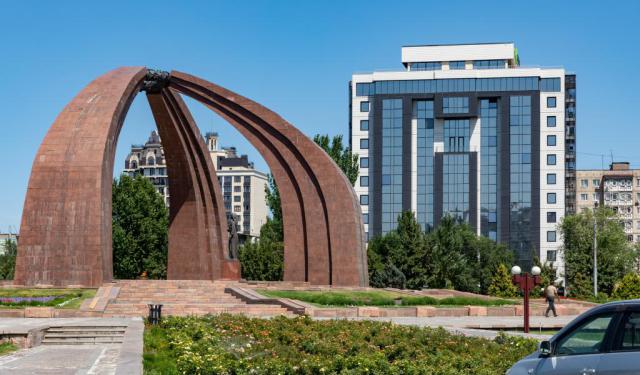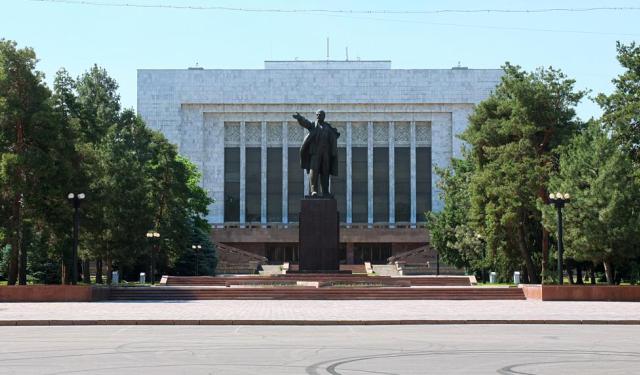
National Library, Bishkek
The National Library has a rich history that reflects the country's evolution and commitment to preserving its cultural heritage. Established in 1934 during Soviet rule in Frunze (now Bishkek), the library was formed by merging the Central City Library and the Scientific Library. Initially named the N.G. Chernyshevsky State Library of the Kyrgyz USSR, it paid homage to the ideologies that fueled the project, with Chernyshevsky being seen as a forerunner to Lenin.
Over the years, the library played a vital role in collecting and preserving publications. In 1939, it became a book depository, receiving mandatory copies of items published in the USSR. In 1940, it started receiving mandatory copies of domestic publications as well. The library's work expanded, and in 1950, the Department of Local Studies and Kyrgyz Books was established to promote Kyrgyz press and local history literature. In 1961, the National Bibliography Department was formed to document works published in Kyrgyzstan, making the records accessible to citizens and centralized authorities in Moscow.
In 1984, the library moved to its current location, a large seven-story building designed to store three million storage units. The building was named after Vladimir Lenin during the Soviet era. After Kyrgyzstan gained independence, the library was renamed the National Library of the Kyrgyz Republic and classified as a valuable national heritage representing the country's historical and cultural legacy. Today, the library is named after Alykul Osmonov, a Kyrgyz poet.
The National Library of Kyrgyzstan serves as a significant cultural institution, preserving and promoting the country's literary heritage. With its vast collection and modern approach to engagement, it continues to play a crucial role in providing access to knowledge and preserving Kyrgyzstan's rich cultural history for present and future generations.
Over the years, the library played a vital role in collecting and preserving publications. In 1939, it became a book depository, receiving mandatory copies of items published in the USSR. In 1940, it started receiving mandatory copies of domestic publications as well. The library's work expanded, and in 1950, the Department of Local Studies and Kyrgyz Books was established to promote Kyrgyz press and local history literature. In 1961, the National Bibliography Department was formed to document works published in Kyrgyzstan, making the records accessible to citizens and centralized authorities in Moscow.
In 1984, the library moved to its current location, a large seven-story building designed to store three million storage units. The building was named after Vladimir Lenin during the Soviet era. After Kyrgyzstan gained independence, the library was renamed the National Library of the Kyrgyz Republic and classified as a valuable national heritage representing the country's historical and cultural legacy. Today, the library is named after Alykul Osmonov, a Kyrgyz poet.
The National Library of Kyrgyzstan serves as a significant cultural institution, preserving and promoting the country's literary heritage. With its vast collection and modern approach to engagement, it continues to play a crucial role in providing access to knowledge and preserving Kyrgyzstan's rich cultural history for present and future generations.
Want to visit this sight? Check out these Self-Guided Walking Tours in Bishkek. Alternatively, you can download the mobile app "GPSmyCity: Walks in 1K+ Cities" from Apple App Store or Google Play Store. The app turns your mobile device to a personal tour guide and it works offline, so no data plan is needed when traveling abroad.
National Library on Map
Sight Name: National Library
Sight Location: Bishkek, Kyrgyzstan (See walking tours in Bishkek)
Sight Type: Attraction/Landmark
Guide(s) Containing This Sight:
Sight Location: Bishkek, Kyrgyzstan (See walking tours in Bishkek)
Sight Type: Attraction/Landmark
Guide(s) Containing This Sight:
Walking Tours in Bishkek, Kyrgyzstan
Create Your Own Walk in Bishkek
Creating your own self-guided walk in Bishkek is easy and fun. Choose the city attractions that you want to see and a walk route map will be created just for you. You can even set your hotel as the start point of the walk.
Bishkek Introduction Walking Tour
The capital city of Kyrgyzstan, Bishkek, is set against the picturesque backdrop of the snow-capped Tian Shan mountains at an altitude of 800 meters above sea level.
Compared to other major cities in Central Asia, Bishkek has a relatively short history. It was founded in 1825, as the Pishpek fortress, during the Russian colonization of the region. The fortress served as an administrative... view more
Tour Duration: 2 Hour(s)
Travel Distance: 3.7 Km or 2.3 Miles
Compared to other major cities in Central Asia, Bishkek has a relatively short history. It was founded in 1825, as the Pishpek fortress, during the Russian colonization of the region. The fortress served as an administrative... view more
Tour Duration: 2 Hour(s)
Travel Distance: 3.7 Km or 2.3 Miles
Soviet Era Architecture and Monuments Tour
While nomadic communities of yurt-living, horse-riding sheep herders are still thriving in the most remote valleys of Kyrgyzstan, the capital city of Bishkek shows a different facet of this Central Asian nation.
Built practically from scratch during the Soviet era, Bishkek experienced significant transformation in terms of urban planning and is packed to the rim with a well-preserved... view more
Tour Duration: 2 Hour(s)
Travel Distance: 3.6 Km or 2.2 Miles
Built practically from scratch during the Soviet era, Bishkek experienced significant transformation in terms of urban planning and is packed to the rim with a well-preserved... view more
Tour Duration: 2 Hour(s)
Travel Distance: 3.6 Km or 2.2 Miles


